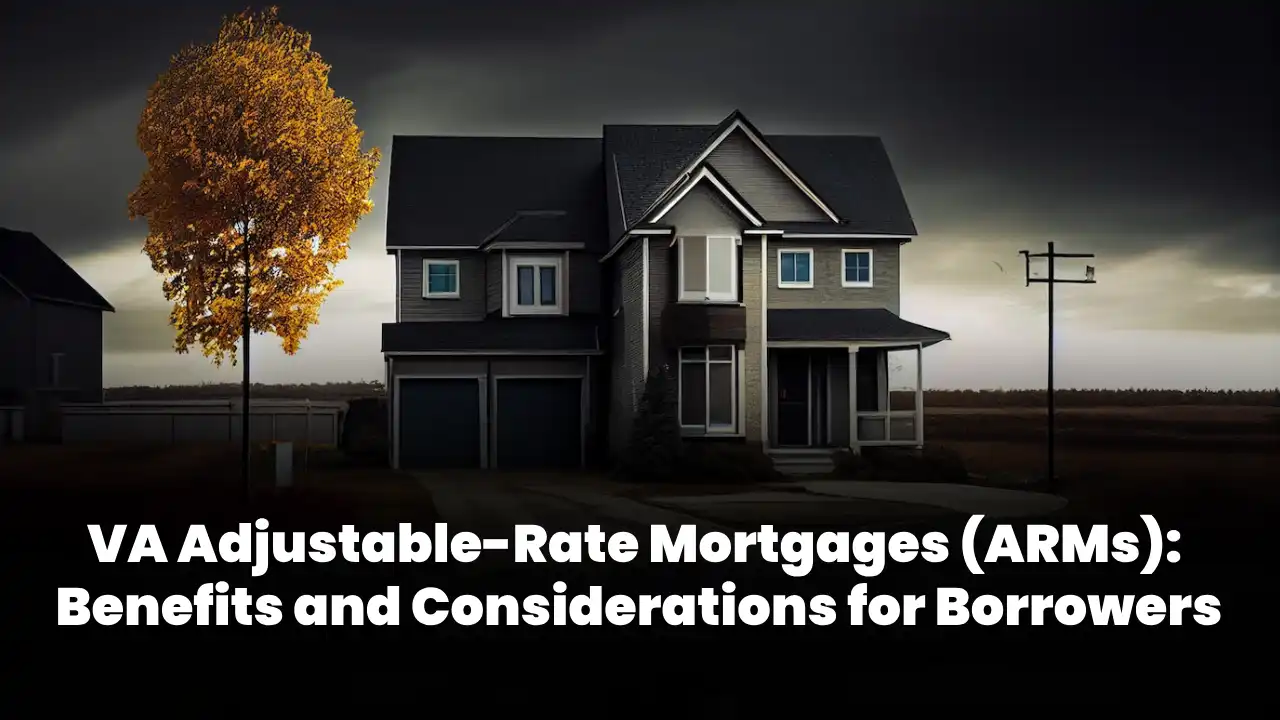When it comes to financing a home, the choices can seem overwhelming. One popular option that veterans and active-duty military personnel may consider is the VA Adjustable-Rate Mortgage (ARM). This type of mortgage offers unique features and potential benefits, but it’s important for borrowers to thoroughly understand what it entails before making a decision.
What is a VA Adjustable-Rate Mortgage (ARM)?
A VA Adjustable-Rate Mortgage, commonly known as a VA ARM, is a home loan option offered by the U.S. Department of Veterans Affairs (VA) that provides eligible veterans, service members, and their spouses the opportunity to purchase or refinance a home with an adjustable interest rate. Unlike a fixed-rate mortgage, where the interest rate remains constant throughout the life of the loan, an ARM has an interest rate that adjusts periodically based on a predetermined index.
Benefits of a VA ARM for Borrowers
Lower Initial Rates: One of the primary advantages of a VA ARM is that it typically offers lower initial interest rates compared to fixed-rate mortgages. This can result in lower monthly payments during the initial fixed period, which is usually a specified number of years.
Potential for Savings: If interest rates remain stable or decrease, borrowers with VA ARMs might benefit from lower interest costs over the life of the loan compared to a fixed-rate mortgage.
Flexibility: VA ARMs often start with a fixed-rate period, which provides borrowers with a predictable monthly payment during the initial phase. This can be advantageous for those who plan to sell or refinance before the adjustable period begins.
Considerations for Borrowers
Adjustment Periods: VA ARMs have predetermined adjustment periods, such as annually or every few years, where the interest rate can change. Borrowers should carefully review the terms to understand how frequently their payments could change.
Interest Rate Fluctuations: After the fixed-rate period ends, the interest rate on a VA ARM can adjust based on market conditions. This means borrowers may face higher monthly payments if interest rates rise.
Budgeting Challenges: The potential for increasing monthly payments can create challenges for budgeting. Borrowers need to consider whether they can afford potential payment increases, especially during the adjustable period.
Long-Term Plans: Borrowers should evaluate their long-term plans for the property. If they intend to stay in the home beyond the initial fixed-rate period, they should be prepared for potential interest rate fluctuations and corresponding payment changes.
How do VA Arms work?
VA Adjustable-Rate Mortgages (ARMs) offer veterans and service members the chance to secure a home loan with a variable interest rate. Unlike fixed-rate mortgages, VA ARMs have an initial fixed period, often several years, during which the interest remains constant. After this period, the rate adjusts periodically based on market indexes. This means monthly payments could increase or decrease, depending on prevailing rates. VA ARMs often start with lower initial rates, potentially leading to lower payments at the outset. However, borrowers should carefully consider their financial stability and long-term plans, as fluctuations in interest rates can impact affordability over time.
How to Calculate Your VA ARM Payment?
To calculate your VA Adjustable-Rate Mortgage (ARM) payment, use the formula: Payment = Loan Amount × [Interest Rate / 12] / (1 – (1 + Interest Rate / 12)^(-Number of Months)). Be sure to input the appropriate loan details, initial rate, and remaining loan term to get an accurate estimate.
How to Apply for a ARM Loans?
- Research and Preparation:
- Understand how ARMs work and their potential benefits and risks.
- Review your financial situation and determine if an ARM aligns with your goals.
- Check Eligibility:
- If you’re a veteran or active-duty service member, see if you’re eligible for a VA ARM.
- For other types of ARMs, check the lender’s eligibility requirements.
- Find a Lender:
- Research and compare lenders offering ARM loans.
- Consider their reputation, interest rates, fees, and customer reviews.
- Gather Documents:
- Collect necessary financial documents, including income statements, credit history, and asset details.
- Pre-Approval:
- Get pre-approved by the lender to understand the loan amount you qualify for.
- Choose Loan Terms:
- Decide on the ARM type, such as 5/1 or 7/1, indicating the initial fixed period and adjustment intervals.
- Submit Application:
- Complete the lender’s application form accurately.
- Provide the required documents for verification.
- Loan Estimate:
- Receive a Loan Estimate outlining the loan terms, interest rate, estimated payments, and closing costs.
- Underwriting:
- The lender reviews your application, credit history, and financial documents.
- They may request additional information for clarification.
- Loan Approval:
- If approved, you’ll receive a commitment letter with the loan terms and conditions.
- Lock the Rate (Optional):
- You may choose to lock in the current interest rate to secure it during the application process.
- Closing:
- Schedule a closing date to sign the final loan documents.
- Review and understand the terms before signing.
- Adjustment Notices (If Applicable):
- For VA ARMs and other adjustable loans, be aware of any adjustment notices regarding rate changes.
Pros and cons of VA ARM loans
Pros of VA Adjustable-Rate Mortgage (ARM) Loans
Lower Initial Rates: VA ARMs often start with lower interest rates compared to fixed-rate mortgages, resulting in lower initial monthly payments.
Potential Savings: If interest rates remain stable or decrease, borrowers may save money on interest over the loan term.
Short-Term Ownership: Ideal for those planning to sell or refinance within the initial fixed period, avoiding potential interest rate adjustments.
Predictable Fixed Period: The initial fixed-rate phase provides predictable payments for a specified period (e.g., 3, 5, 7 years).
Beneficial for Relocation: Suited for military personnel with frequent relocations due to station changes or deployments.
Read More: What Is Community Property
Cons of VA Adjustable-Rate Mortgage (ARM) Loans
Interest Rate Risk: After the fixed period, the rate can adjust periodically, leading to potential payment increases if market rates rise.
Uncertain Payments: Monthly payments can fluctuate, making long-term budgeting challenging.
Long-Term Costs: If rates rise significantly, borrowers could end up paying more in interest over the life of the loan compared to a fixed-rate mortgage.
Payment Shock: Substantial rate hikes after the fixed period may lead to payment shock, straining the borrower’s finances.
Potential for Negative Amortization: In some cases, low initial payments may not cover the interest, leading to an increase in the loan balance.
What is a VA ARM?
A VA Adjustable-Rate Mortgage (ARM) is a type of home loan for eligible veterans and military members that starts with a fixed interest rate before becoming variable over time.
Can you get a VA ARM?
Yes, eligible veterans and active-duty military members can obtain a VA Adjustable-Rate Mortgage (ARM) to finance a home purchase or refinance, benefiting from its adjustable interest rate structure.
What are the VA ARM Rates?
VA ARM rates vary based on prevailing market conditions, index rates, and lender offerings. Initial rates are often competitive, making them an attractive option for eligible veterans and service members seeking flexible mortgage solutions
Who has the best va loan rates?
VA loan rates can vary among lenders. Research multiple financial institutions, credit unions, and online mortgage providers to compare rates and find the best option tailored to your circumstances.
Conclusion
A VA Adjustable-Rate Mortgage can be an attractive option for eligible veterans and service members who are looking to purchase or refinance a home. The lower initial rates and potential for savings can make it an appealing choice. However, borrowers must carefully assess their financial situation, risk tolerance, and long-term plans before committing to a VA ARM. Understanding the terms, potential adjustments, and the impact of interest rate fluctuations is essential for making an informed decision that aligns with their financial goals. Consulting with a qualified mortgage professional can provide valuable insights and guidance throughout the decision-making process.







